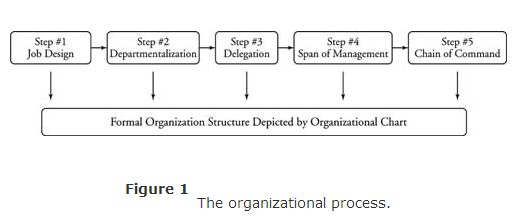The Organizational Process
Organizing, like planning, must be a carefully worked out and applied process. This process involves determining what work is needed to accomplish the goal, assigning those tasks to individuals, and arranging those individuals in a decision‐making framework (organizational structure). The end result of the organizing process is an organization — a whole consisting of unified parts acting in harmony to execute tasks to achieve goals, both effectively and efficiently.
A properly implemented organizing process should result in a work environment where all team members are aware of their responsibilities. If the organizing process is not conducted well, the results may yield confusion, frustration, loss of efficiency, and limited effectiveness.
In general, the organizational process consists of five steps (a flowchart of these steps is shown in Figure 1):

1.Review plans and objectives.
Objectives are the specific activities that must be completed to achieve goals. Plans shape the activities needed to reach those goals. Managers must examine plans initially and continue to do so as plans change and new goals are developed.
2.Determine the work activities necessary to accomplish objectives.
Although this task may seem overwhelming to some managers, it doesn't need to be. Managers simply list and analyze all the tasks that need to be accomplished in order to reach organizational goals.
3.Classify and group the necessary work activities into manageable units.
A manager can group activities based on four models of departmentalization: functional, geographical, product, and customer.
4.Assign activities and delegate authority.
Managers assign the defined work activities to specific individuals. Also, they give each individual the authority (right) to carry out the assigned tasks.
5.Design a hierarchy of relationships.
A manager should determine the vertical (decision‐making) and horizontal (coordinating) relationships of the organization as a whole. Next, using the organizational chart, a manager should diagram the relationships.